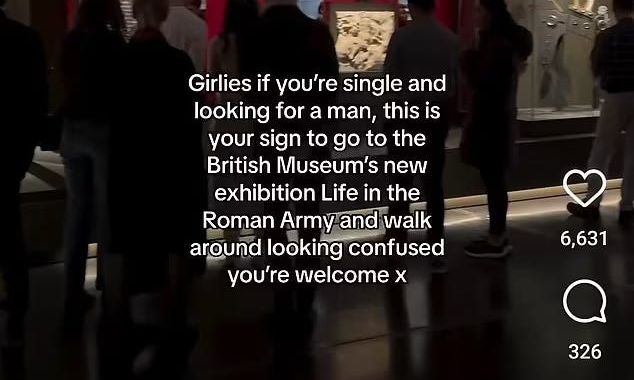The British Museum took to the Instagram comments to defend the post
CSMFHT via Substack; British Museum via Instagram
The British Museum had a social media meltdown last month. On 3 March, it re-posted a video on its TikTok and Instagram channels that read: “Girlies, if you’re single and looking for a man, this is your sign to go to the British Museum’s new exhibition, Life in the Roman Army, and walk around looking confused. You’re welcome x.”
The meme, capturing the British Museum’s show Legion: Life in the Roman Army (until 23 June), was originally posted on TikTok in February by a female content creator, @hrhgeorgiana. The video riffs on a trend on the app of asking men how often they pondered the Roman Empire, and another trend about women looking for suitors by acting confused at hardware stores.
The video did not hit right—particularly not on Instagram, where it was immediately decried as sexist. The British Museum responded in the comments section, explaining that “mansplaining is the butt of the joke… we can assure you that we are *not* actually suggesting that women need to look for dates or pretend to be stupid!” It later deleted the posts altogether and released an official apology. As Cem A., the artist known for running the irreverent @freeze_magazine social media accounts, argues: “Even if you ignore the inexcusable sexist nature of the joke, perhaps the meme wasn’t so funny if you have to go out of your way to explain the joke to so many people.”
Social media is a tricky game and posts can sometimes backfire—but the British Museum’s reaction was also problematic. “We would’ve advised against defending the post in a comment reply,” says Sierra LaDuke, the co-founder of Send It Social, a US-based social media consultancy for the cultural sector. “It’s unlikely that you’ll change anyone’s opinion, and it might appear as if you’re engaging in an argument, which will result in more negative interactions.”
“There are so many things that make social media ripe for organisational boo-boos; it’s like a rolling, 24/7 bid to be relevant,” says Louise Cohen, a content strategist at One Further, a digital consultancy for the arts industry. “Posting from several channels multiple times a day, it’s not realistic for all content to go through the same institutional channels of approval as things like press releases.”
Many art organisations have been struggling to find their voices on social media. “An institution has to somehow be both a behemoth brand and a witty, irreverent person. Be official and authoritative—but be real and connect with people. It’s a fine line,” Cohen says. Diverse audiences make the job even harder, says LaDuke: “They’re speaking to a broad audience that spans different ages, cultures and levels of familiarity with the arts. Plus, social media trends and audience expectations are always shifting, making it a moving target.”
So, if social media backlashes are almost inevitable, how should art institutions prepare for them? “Make sure that your organisation has clear guidelines for what to do in these sorts of situations; these help staff to feel supported when they’re in the thick of it,” says Alec Ward, a consultant and lead for digital content and skills at the Audience Agency, a UK audience development charity for the cultural sector. He points to a useful online toolkit from Rebuilding Heritage, “Crisis Communications for Social Media”.
LaDuke recommends setting up a content review committee. “It can be casual, like a group chat on Slack or WhatsApp,” she says. “Let them take a look and tell you what they really think.” One of the issues in the case of the British Museum’s post is the translation of a TikTok trend onto the Instagram platform; Cohen says tailored strategies by channel can be useful, rather than blind cross-posting.
But Cohen warns against art organisations playing it safe on social media. “Museums have incredible assets that enrich our lives, and their challenge is to find the right way to serve them up to us while we eat our lunch,” she says. “That often requires some risk, and every institution has a different threshold for it. But the ones who take no risks are often the ones who aren’t getting very far.”

